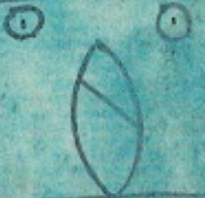Ome Tecpatl (Mdz2r)
This simplex glyph, combined with a notation, stands for a solar year (xihuitl) date, Two Flint (or Two Flint Knife). It has the notation (two ones, ome) on the top and the flint knife (tecpatl) standing upright below. The ones are small circles with a dot in the center. The knife has a diagonal line across it, leaning to the left. The entire date (including the background) is painted a turquoise (xihuitl) color, and it is enclosed in a black line-drawing box (which is not shown here).
Stephanie Wood
A box is an indicator that this is a date. The terms for year and turquoise are the same--xihuitl. The use of homophony may be reflected in the turquoise blue paint washing over the contents of the box, providing a phonetic indicator that this is a year date.
Moctezuma (or Motecuhzoma) Xocoyotl died in 1520, which was a Two Flint (or Two Flint Knife) year. (See: Berdan and Anawalt, The Essential Codex Mendoza, 1997, 24.)
Stephanie Wood
c. 1541, or by 1553 at the latest
dates, fechas, ones, numbers, números, years, años, pedernales, xiuhpohualli, turquesa, xihuitl

ome, two, https://nahuatl.wired-humanities.org/content/ome
tecpa(tl), flint, flint knife, https://nahuatl.wired-humanities.org/content/tecpatl
Dos Pedernal
Stephanie Wood
Codex Mendoza, folio 02 rect, https://digital.bodleian.ox.ac.uk/objects/2fea788e-2aa2-4f08-b6d9-648c00..., image 14 of 188.
The Bodleian Libraries, University of Oxford, hold the original manuscript, the MS. Arch. Selden. A. 1. This image is published here under the UK Creative Commons, “Attribution-NonCommercial-ShareAlike 3.0 License” (CC-BY-NC-SA 3.0).
